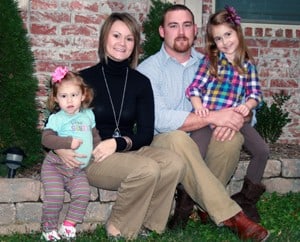Searcy Mom, Teacher Thankful for Stroke Program
| Double vision was the first symptom Ticia Covington, 25, of Searcy noticed while she was getting ready for her fifth day as a school teacher.
The mother of two called for her husband, Reagan, and asked him if her eyes looked crossed. About that time her right side suddenly weakened, causing her to fall.

Life was quickly back to normal for Ticia Covington (second from left) and her family after she received emergency stroke treatment through the UAMS-led AR SAVES program.
“Reagan picked me up and as he was talking to me he began to notice pulling of my mouth, my nose and my eye,” Ticia said. At that point, both were thinking the unthinkable: stroke.
“My speech was slurred; I had all the classic symptoms of a stroke, so we knew I needed to get to the hospital,” Ticia said.
Reagan immediately called her parents, who live nearby, to stay with their children, ages 4 and 1, before taking Ticia to White County Medical Center in Searcy.
Fortunately for Ticia, the hospital recently partnered with the UAMS-led Arkansas SAVES (Stroke Assistance through Virtual Emergency Support) program. The SAVES program uses a high-speed video communications system to help provide immediate, life-saving treatments to stroke patients 24 hours a day. The real-time video communication enables a stroke neurologist at a distant location to evaluate whether emergency room physicians should use a powerful clot-busting drug within the critical 4.5-hour period following the first signs of stroke.
The program is a partnership between the UAMS Center for Distance Health, the state Department of Human Services, the Department of Health and Sparks Regional Health System in Fort Smith.
As participants in the program, White County Medical Center staff are specially trained by the UAMS Center for Distance Health to provide preliminary stroke assessments to determine whether to activate the SAVES link with a stroke neurologist at either UAMS or Sparks.
In Covington’s case, the emergency room staff quickly determined that she was having a stroke and connected via telemedicine with Margaret Tremwel, M.D., at Sparks. Tremwel recommended that Covington receive tissue plasminogen activator (t-PA), the powerful blood thinner. She had arrived at the hospital within about 25 minutes and received the t-PA within about an hour.
“I didn’t know anything about the SAVES program, but I am so thankful it was there for me,” Covington said. “At the time I was thinking, ‘How am I going to take care of my kids? And what about my kids at school?’ My husband said he was thinking how unfair it was to me.”
Two hours after receiving the t-PA, Covington was flown to UAMS, where she was seen by Salah Keyrouz, M.D., a stroke neurologist and medical director of the SAVES program.
“I got better by the hour,” Covington said.
She left UAMS two days later using a walker. Within a week she could walk without assistance, and within two weeks her vision was back to normal.
“I went back to teaching a month after the stroke; I’m fine,” Covington said after a follow-up visit with Keyrouz. “He said it was if I had never had the stroke, and that I can live my life as if I never had a stroke.”
Keyrouz also concluded that the likely culprit of her stroke was her birth control medicine.
Oral contraceptives nearly double the risk of stroke, according to a 2009 review article in MedLink Neurology by three Loyola University Health System neurologists.
“I’m not taking birth control medicine anymore, so I don’t have to worry about it,” she said. “It’s also a relief knowing there’s nothing genetic that could put my children at risk for stroke.”